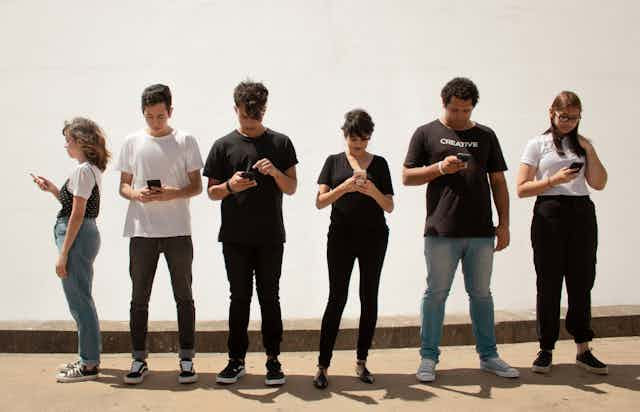Our digital world is bigger and more connected than ever. Social media isn’t just a daily habit – with more than 5 billion users globally, it’s woven into the very fabric of our existence.
These platforms offer entertainment, connection, information and support, but they’re also battlegrounds for misinformation and online harassment.
Platforms like Facebook, YouTube, Instagram and TikTok vie for our attention, each boasting user counts in the billions. But what do these numbers actually tell us, and should we care?
What is an active user or a unique user?
Behind the impressive statistics lies a complex reality. While global social media usership has hit the 5 billion mark, representing about 62% of the world’s population, these figures mask the intricacies of online participation.
In Australia, the average person juggles nearly seven social media accounts across multiple platforms. This challenges the assumption that user counts equate to unique individuals.
It is also important to differentiate between accounts and active users. Not all accounts represent actual engagement in the platform’s community.
An “active user” is typically someone who has logged into a platform within a specific timeframe, such as the past month, indicating engagement with the platform’s content and features. They’re measured with analytics tools provided by the platform itself, or with third-party software.
The tools track the number of unique users – that is, individual accounts – who have interacted with or been exposed to specific content, whether a post, story or advertising campaign.
Social media companies use these metrics to showcase the potential reach of their platform to marketers. It’s key to their business model, as advertising revenue is typically their main source of income.
However, the reliability of these statistics is debatable. Factors such as bot accounts, inactive accounts and duplicates can inflate numbers, offering a distorted view of a platform’s user base.
Moreover, the criteria for an “active user” vary across platforms. This makes it difficult to make comparisons between user bases and to truly understand online audiences.

User count isn’t always relevance
TikTok boasts a staggering 1.5 billion users globally. This doesn’t even include users on its Chinese counterpart, Douyin. It is also often at the centre of controversies and geopolitical tensions.
For example, TikTok has repeatedly faced threats of bans in significant markets such as the United States, raising questions about future access. But with such a vast user base, TikTok’s impact on culture and trends – particularly among young people – is clear and far-reaching.
Read more: If TikTok is banned in the US or Australia, how might the company – or China – respond?
However, the true impact of platforms is further muddied by algorithms – the complex formulas that dictate the content we see and engage with. Designed to keep us scrolling and interacting, they significantly shape our online experiences.
They also complicate how “active” a user might appear. Someone could seem more engaged simply because the algorithm promotes content they interact with more often.
So, while a high active-user count might indicate a platform’s popularity and reach, it doesn’t fully capture its influence or social relevance. True engagement goes beyond numbers, delving into the depth of user interaction, the quality of the content, and the cultural impact these platforms wield.
Different strokes for different ages
When we look at the users’ demographics, we see distinct preferences across age groups.
Among the younger crowd, specifically Gen Z, TikTok vastly outpaces Instagram with one in four users under the age of 20.
Meanwhile, Snapchat and Instagram are the preferred platforms for people aged 18–29.
Facebook, with its massive user base of more than 3 billion and a median user age of 32, is the platform of choice for millennials, Gen X and boomers.
Read more: 'OK Boomer': how a TikTok meme traces the rise of Gen Z political consciousness
People in their 30s and older tend to use LinkedIn and X (formerly Twitter) more than platforms like Snapchat.
But all these social media platforms tend to vary in their primary focus, from news and professional connections (like LinkedIn) to predominantly serving entertainment (like TikTok).
This means demographic trends also reveal how each platform impacts users differently, catering to varied content preferences – whether it’s for entertainment, staying updated on news and events, or connecting with friends and family.

User count isn’t what matters
For content creators and news media, delving into user statistics is crucial if they want to reach their target audiences.
However, despite headlines often focusing on vast user numbers, do these figures actually matter to the everyday social media user? Research I’ve done with colleagues suggests they don’t.
For individuals navigating these digital spaces, it’s not about which platform boasts the highest user count and is therefore deemed “important”.
Instead, the focus is on maintaining connections within their social circles. This preference is rooted in cultural practices, meaning it aligns with the habits, preferences and values of their own community or cultural group.
In other words, people are drawn to social media platforms that are popular or widely accepted among their family, friends, social allies and broader cultural community. This suggests the essence of social media lies in the quality of interactions rather than the platform’s global standing.
Whether for staying informed, being entertained, or nurturing relationships, people gravitate to spaces where their community or “tribe” gathers.
Read more: It's hard to imagine better social media alternatives, but Scuttlebutt shows change is possible

